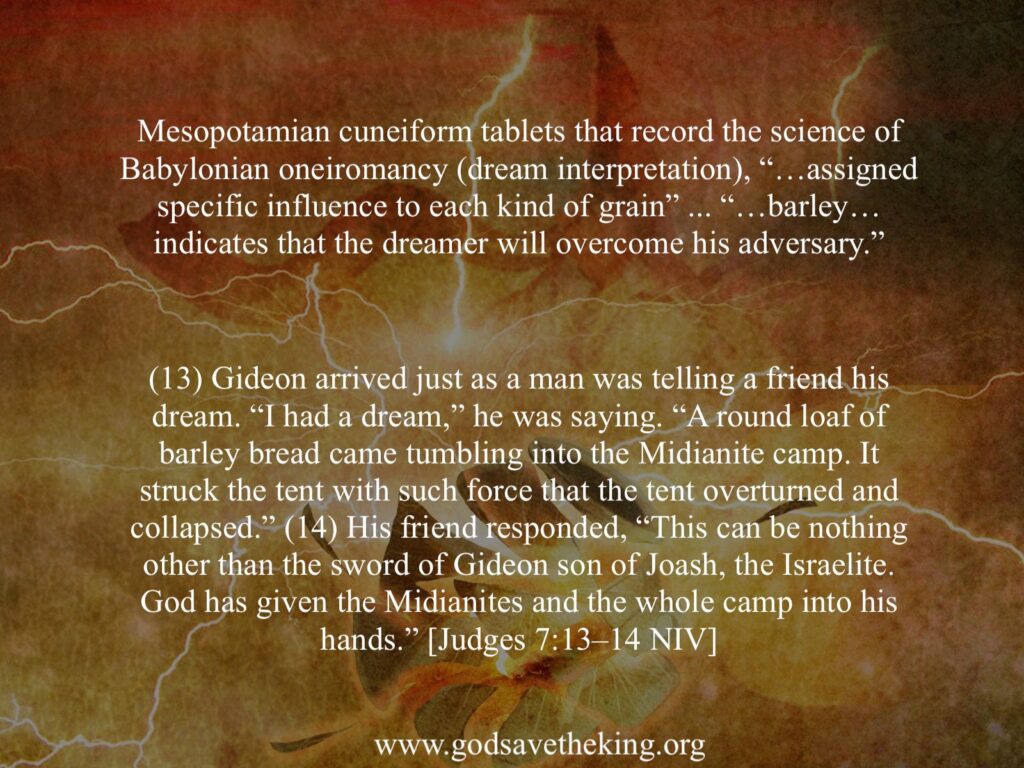
The story of Gideon is something of a riddle. In it we are continually presented with ideas that don’t really seem to make sense. Gideon professes that he is the least in his family, and from one of the weakest clans in the tribe, and yet the angel of the Lord declares Gideon to be a “mighty man of valor”. Later in the story, the Lord directs Gideon to sneak down to the enemy’s camp in order to obtain some sorely needed encouragement–but this doesn’t seem to add up. How does a person who desperately needs encouragement, have the courage to sneak into the enemy’s camp, in order to get encouragement? If that sentence doesn’t confuse you, you’re not reading carefully enough.
When Gideon does sneak into the enemy’s camp, he winds up outside the tent of a Midianite soldier who has just had a dream. He tells the dream to his companion who interprets the dream as representing their doom. And what is the terrifying symbol in the dream that represents their utter destruction?
A loaf of bread. (Insert anticlimactic music here.)
But Gideon was rightly represented by a loaf of bread as he and his outnumbered army of 300 men were unlikely to conquer the enormous Midianite army. The book of Judges describes this army as thick as locusts and their camels as the sand on the seashore! But Gideon and his mere 300 men defeated them. Midian was subdued, never to rise again. Hence, the loaf of barley bread knocking out a tent, as comical and improbable as it was, is nonetheless a fitting symbol for Gideon and his army. The story of Gideon is the story of strength in weakness because behind the tumbling bread was God’s spirit and power.

Although the majority of cuneiform tablets recovered from the famous library of Ashurbanipal at Nineveh concern Mesopotamian astronomy and astrology. The wise men of king’s court practiced many forms of divination including oneiromancy (dream interpretation). Among the tablets on display in the British Museum are several tablets that are concerned exclusively with oneiromancy and are therefore labeled “Dream Tablets”. Part of the translated tablets tell us that Babylonian oneiromancy, “…assigned specific influence to each kind of grain” and that “…barley…indicates that the dreamer will overcome his adversary.”
Granted, a hyper-accurate deciphering of the record in Judges 7 indicates that it was a Midianite that was doing the dreaming, not Gideon, and therefore the Midianite should be the one overcoming his adversary for the symbolism to be true, but this is not necessarily the case. The Midianite dreamer and his interpreter believe the barley loaf represents Gideon (not themselves) and therefore the dream symbolism proves accurate.
Virtually all ancient cultures treated dreams as an especially important way of receiving messages from God, “the gods”, or the spirit world. Almost no important work of ancient literature lacks a reference to dreams, their interpretation, and their influence on human attitudes and actions. Isn’t it provocative that a Mesopotamian cuneiform tablet may demonstrate a keen parallel to the biblical text?
Wise men and royal advisors participated in the courts of all ancient empires. One of their more common practices was to seek to understand all forms of communication from the gods (God), whether by augury, oneiromancy, astrology, and many other forms of divination. They would collect this information and present it to the king in what we would refer to today as an intelligence briefing. These briefings were often recorded by writing on clay tablets. Thousands of years later, today, we are translating and deciphering the mysteries of the wise men recorded on these tablets.
God Save the King